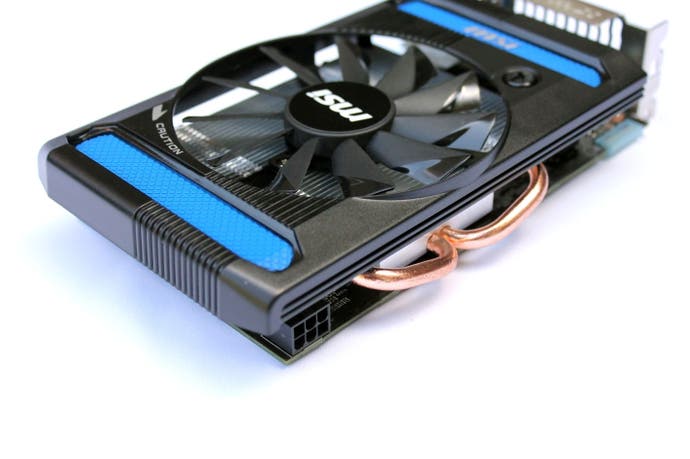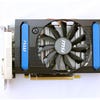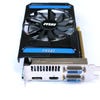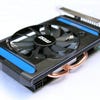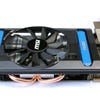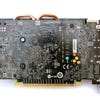Radeon HD 7790 review
Next-gen Xbox graphics tech re-factored for the PC market?
What if you could buy the graphics tech that's set to feature in the next generation Xbox and slot it into your existing PC? That's the scenario being suggested by some with the Radeon HD 7790 - a circa £115 card that counts as the first product release by the company this year. Based on leaked details of Microsoft's "Durango" console's GPU, there are more than a few curious design overlaps with this budget-conscious 7790, suggesting a shared origin in the architecting phase - a situation that could prove revealing of the kind of ballpark performance we can expect on the hardware's launch, where PC ports are the most likely scenario for cross-platform titles.
The case for the 7790/Durango link is built on several points. Among them is AMD's use of an updated version 1.1 of Graphics Core Next (GCN) 28nm chipset for the card, codenamed Bonaire XT. This is an overhauled take on the Cape Verde board seen in the 7770, with a downsized 160mm2 die helping to lower its thermal profile, make the unit more power-efficient, and ensure it's even cheaper to produce en-masse.
The updated chipset also crucially features the ability to process two primitive functions per clock, as compared to just the one possible on the 7770, offering the potential for improved Compute and tessellation performance more in line with Pitcairn cards like the 7850 and 7870. Some of these streamlining improvements are expected of any trickle-down revision of PC parts, of course, but the nature of such a costly up-ending to a lower-end card's architecture is unusual - and its timing is revealing.
Production of just such a power-light and heat-efficient GPU in this vein makes for a clear fit for Durango. Based on currently known specs it's clear Microsoft is drawn to keeping component costs to a minimum for this generation, which fits the price spec of the card like a glove too. Many of these key specifications would be set in stone already; since principle design is already in the bag for AMD, it makes sense to see some of its power-saving refinements filter through to the company's efforts in the PC market too - with the 7790 spear-heading the movement in that field
However, there are apparent differences between the two based on current information. For starters, Microsoft's leaked whitepapers suggest that the Durango GPU has just 12 compute units compared to the 14 on the 7790 (and the 18 in the PS4), while its 800MHz core clock is on the shy side of the 1GHz seen in this card. Our information also suggests that the Microsoft platform boasts a 256-bit memory interface, though an evident bottleneck is in effect as a result of DDR3 memory being used - resulting in 68GBps overall bandwidth here. Fortunately this is brought up to speed by the generous 102GBps throughput of Durango's 32MB ESRAM, which we understand can operate in parallel with the DDR3. By comparison, it is curious that we're seeing a restrictive 128-bit interface in use for the 7790 here; despite access to a much faster set of 1GB GDDR5 memory, the card's transfer rate is cut down to 96GBps.
As a lower-end offering released to strong existing competition, the 7790 sticks out like a sore thumb at its current price-point. The card's specs are placed halfway between the Cape Verde units such as the 7770, and the Pitcairn releases like the 7850. However, the problem is that the 1GB edition of the 7850 already occupies similar circa £125 territory, while the better technical match from Nvidia is the GTX 650 Ti that currently lurks around the £100 range.
As we mentioned in our article on future-proofing PCs for next-gen gaming, using the lower 1GB memory configurations for each of these cards is well-suited for 1080p gaming on a budget. However, AMD's 7850 has the 7790 assuredly beaten in most other regards. Overlooking the higher core and memory clocks of this new card, we're left to compare a liberal 256-bit memory interface, 32 render output units (ROPs) and 1024 stream processors to the Bonaire card's halved memory interface, 16 ROPS and lowered 896 processor count. Many of these lower specs are shared by the 650 Ti too, meaning that if there's any advantage to this new release, it must stem the updated GCN architecture when put into practice with DirectX 11 games themselves.
Performance analysis: gameplay tests
We've lovingly taken up the beautiful Crysis 3 as our new flag-ship performance test - which alongside Battlefield 3 gives us a glimpse of the effects quality and rendering techniques we can expect for next-gen console titles. Both Frostbite 3 and CryEngine 3 are poised to dominate the scene as middleware solutions within Electronic Arts, with the former crossing over to upcoming BioWare titles such as Dragon Age and Mass Effect.
As such, it's essential that a card bearing familial ties to the upcoming Durango GPU should be have the mettle to see through 1080p playback in each game. Whether or not it can also nail 60FPS remains to be seen; once again, we aim to find out by loading the card into a Core i5 Sandy Bridge PC clocked at 4.2GHz, and coupled with 8GB DDR3 RAM.
The overwhelming verdict here is that - for matching scripted scenes at least - both the 7790 and 650 Ti push out around 50FPS on medium settings in Crysis 3. The lead is often AMD's by a matter of two frames per second, though this gap is crow-barred wide open during battles in the rainy Post-Human opening mission, where we can experience a difference of up to 10FPS. Given the weather effects and number of enemies in this scene especially, a shortfall in processing power for the Nvidia card is made much more evident here.
"Our gameplay testing reveals a significant advantage for the 7790 over the GTX 650 Ti, but the 7850 still commands the lead - except, weirdly, in DICE's Battlefield 3..."
Alternative Analysis:
We see a similar disparity in performance with Battlefield 3 too, running on the high preset with post-process AA, screen-space ambient occlusion and motion blur enabled by default. Much like Crytek's shooter, these additional effects give each card a strong DirectX 11 work-out, backed up by the game's tessellated environments and characters. But when it comes down to the hectic battle sequences during the Operation Swordbreaker mission, both cards unfortunately fall short of the 60FPS target. There's a diligent adherence to 50FPS instead, which adds a degree of stutter to panning motions, while the the GTX 650 Ti dips almost 15 per cent lower than the 7790 in like-for-like scenarios.
Multi-sample AA is the killer for high-end games and bears down on the 96GBps fill-rate of the Bonaire card. As shown by ramping The Elder Scrolls 5: Skyrim up to its ultra preset, the forcing of 8x MSAA here gives us the very worst results of the three at circa 40FPS. Again, results are a hair's whisker away from Nvidia's equivalent card, but always ahead as we ride down the hill.
But what of AMD's own competition in the 7850? Inevitably there's no catching up to the Pitcairn-based card in terms of fill-rate, which fully engages the high resolution and MSAA of each title with its 153.6GBps memory bandwidth. For Skyrim, the net result is that the higher-end card gets away with the maximum frame-rate possible for 60Hz displays, with all bells and whistles attached. The success story continues in Crysis 3, where dips down to 45FPS are possible, but not as sustained as the arcing lurches down seen on the 7790.
It's Battlefield 3 which offers the strangest returns in performance, where we see the cheaper card's play-through mimicking performance readings of the 7850 through thick and thin. It's uncanny how close these cards are in the final call, and while the higher-end card pips it to the post in most scenarios, it's still a very gruelling tussle for 50FPS between the two.
To test other recent games, we also compiled a sequence of scripted in-engine benchmarks for games which support them. For each title in the video reel, from Metro 2033 through to BioShock Infinite, we continue to target 1080p resolution as the golden standard, with high settings engaged where possible.
Alternative analysis:
Continuing the trend seen in our previous GTX 650 Ti Boost review, it appears driver support for AMD cards is better across Square Enix titles in particular. Coincidence or not, our 7790 plays the likes of Hitman Absolution, Tomb Raider and Sleeping Dogs with up to a 20 per cent lead over the GTX 650 Ti, with all games pushing above the 30FPS mark with 2x MSAA enabled. It's also possible to draw out an almost perfectly fluid response from Tomb Raider at these high settings, with TressFX hair physics added in too.
The Metro 2033 benchmark test remains humbling for every card, running on its DirectX 11 setting with depth-of-field included. It's not representative of the main game, thankfully, since every physics-based process and lighting trick is being hurled at the screen at once here - though it easily ranks as the best stress-test of its sort. The division between the 650 Ti, 7790 and 7850 is clear cut from this test, with frame-rate ascending in order of price-point. However, it must be said that it's the latter card which pulls away with a disproportionately high grade of performance. For £10 extra over the 7790, the 7850 excels by a considerable margin in every test here, proving especially true of Unreal Engine 3 titles like Batman: Arkham City.
| GTX 650 Ti 1GB | Radeon HD 7790 1GB | Radeon HD 7850 1GB | |
|---|---|---|---|
| BioShock Infinite | 61.1 | 60.5 | 81.5 |
| Hitman Absolution | 28.2 | 35.5 | 46.7 |
| Batman: Arkham City | 71.0 | 65.0 | 89.0 |
| Tomb Raider | 49.1 | 53.4 | 69.4 |
| Sleeping Dogs | 38.0 | 45.9 | 56.3 |
| Metro 2033 | 19.0 | 23.7 | 32.6 |
Radeon HD 7790: the Digital Foundry verdict
"The 7790 is a good card that competes well against its nearest Nvidia rival - but the 7850 offers much more performance for just £15 extra..."
AMD's first new GPU for 2013 has distinguished itself by improving significantly on its previous 7770, but doesn't redefine our expectations of a low-end card. The 7790 stands as a powerful DirectX 11 card that demands only a miserly 85 watt maximum TDP. In this sense it's impressive that the card manages to handle a smoother grade of performance compared to more power-hungry 110 watt intake of the GTX 650 Ti's Kepler setup. Revisions made to the GCN architecture also reap surprising dividends for compute-task heavy titles like Battlefield 3. In our lengthy test of DICE's latest shooter, the big shock here is that this new AMD card can match performance of the more expensive HD 7850 in its 1GB configuration, almost frame-for-frame.
However, in terms of overall design philosophy, AMD's approach to creating a quieter, smaller card with a lower thermal profile makes the 7790 a success in streamlining its tech. Should the Bonaire chipset have any relation to the next Xbox GPU, this bodes very well for the overhead in heat and power it holds - plus the implied effects on production costs during the fabrication process. That said, spec differences between the 7790 and the rumoured Durango GPU are great and many, with compute unit counts, plus the core and memory clocks on the PC card offering a big advantage, while the next-gen Xbox should offer a bandwidth advantage. Even so, as a ball-park estimate of where AMD's current GCN technology stands, the 7790 shows us that playing true next-gen titles at 1080p is clearly within reach.
Assessed on its merits within the PC market, the card remains slightly on the dear side at £110. It's all relative of course: in an ideal scenario the card would show-up Nvidia's GTX 650 Ti by sharing the £100 price-tag, leaving the 7850 room to stretch around the £125 mark. It's a green banana right now, but given another month of price cuts this card is ripe for the picking; despite being saddled by a narrow 128-bit memory bus, the HD 7790 safely holds its own so long as you're not intending to broach 1440p territory.
